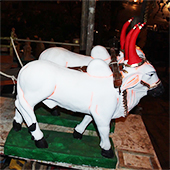Design Resource
Indian Wooden Bullock Cart - Nashik, Maharashtra
Farmer’s Traditional Vehicle
by
Prof. Bibhudutta Baraland Guna D.
The process starts by making the base of the cart. Artisan uses try square and marks on a wooden slab where the wood has to be cut. Hacksaw is used to manually cut the marked areas. He takes a smaller sized wooden stick, marks and cuts the same (set 1). Carpenter plane is used to shave off the surface of the wood (set 1) and make it even. Round file is used next to shape the wood accordingly. The artisan takes two more pieces of wood (set 2) and chisels out one corner of the wooden sticks and files the chiseled place to make the corners smooth; to the other corner he cuts a little of wood slightly away from the edge with the saw. (set 1) wooden sticks are stuck using adhesive on the wooden block facing upwards on opposite sides. To make these more secure he pounds them with nails using hammer on two sides. (Set 2) wooden sticks are stuck on the sides of the wooden block, opposite to set 1 wooden sticks so that the corners of set 2 sticks come below set 1. He strengthens the fix by striking with nails using hammer. The base of the cart is ready.
Two more wooden sticks (Set 3) which are slightly thicker and of equal measure are taken next. On one end of both the sticks the inner portion is minutely cut at an angle. They are smoothed by carpenter plane. The cut ends are stuck on top of each other with adhesive and fastened with nail. This is the trace for the cart. A shorter wooden piece is fixed to the trace as the yoke of the cart. Yoke and trace is stuck to the base of cart using adhesive. Artisan clasps the yoke to vice to hold it affirm. Holes are drilled on both corners using manual grilling tool and nails are pierced in the holes and fixes the yoke and trace to the base.
Five short pieces of wood (set 4) are stuck vertically on a wooden stick. Two pieces similar to set two are nailed to this securely. Another set of woods are placed and the same process is repeated. These pair of sets are stuck on top of the base on opposite sides. Wheels are fixed to the base.
Wood varnish is painted all over the cart to give it a shining look and it keeps the wood away from damage. Few minor decorative articles are added to make the craft extravagant.
Flow Chart:























